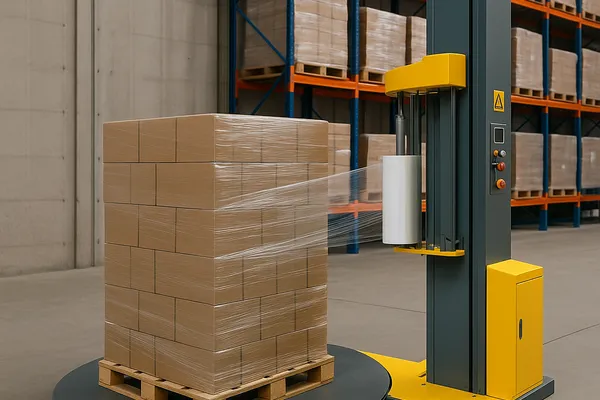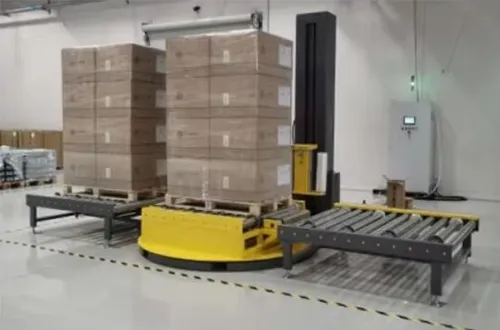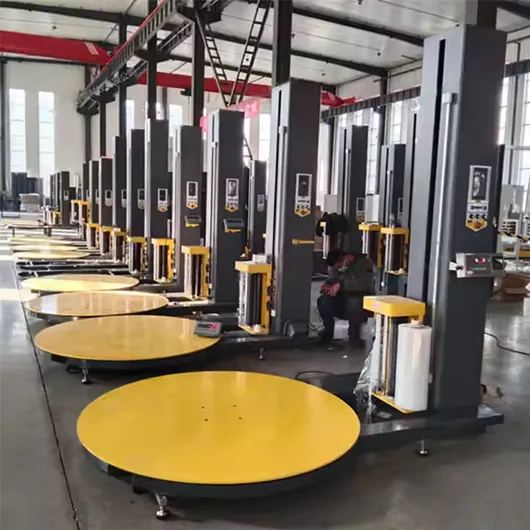Avoid your inquiry is delay response, please enter your WhatsApp/Skype along with the message, so we can contact you at the very first time.
We will reply you within 24 hours. If for urgent case, please add WhatsApp/WeChat: ,. Or call directly.
Many factories still hand-wrap pallets, wasting time and money while damaged goods keep eating into profit. The problem grows as orders rise and staff are already stretched. A smarter, safer way to wrap every pallet is no longer optional – it is critical.
An automatic pallet wrapper uses stretch wrap to secure each load to a pallet with consistent tension and coverage. This makes the pallet much more stable, cuts product damage, and reduces manual work at the end of the line, especially for high-volume operations.
An automatic pallet wrapper is a type of pallet wrapping machine that uses a motorized system to wrap a pallet load with film in a repeatable pattern. Instead of a worker walking around with a roll of film, the machine does the wrapping process for them, layer by layer, around the pallet.
Most modern wrapping machines use a rotating turntable or a moving mast to rotate or move the load while the film carriage travels up and down. The machine controls the wrap cycle, the wrap height, the number of top and bottom wraps, and how tightly the film pulls against the load. In simple words, it makes each wrap the same, every time.
As a professional manufacturer of automatic packaging machines, we design our pallet wrapper systems to handle everything from light cartons to heavy-duty bags and drums. Our machines are built to keep each pallet stretch pattern consistent, so you wrap pallets securely without crushing cartons or leaving the pallet loose.

What is an automatic pallet wrapper
When people search for a stretch wrap machine, they often compare a fully automatic stretch system with a semi-automatic stretch model. The difference is how much help the operator must give the machine during each wrap. Both options can improve your packaging process, but they fit different plants.
A semi-automatic pallet wrapper usually needs the operator to place the pallet with a forklift, attach the film to the tail to the load, start the cycle, and cut the film at the end. These semi-automatic machines provide a big step up from hand wrapping, yet they still demand some manual steps and stopping points in the packaging line.
An automatic stretch wrap machine goes further. With automatic stretch wrap, a conveyor system can bring the pallet load into position, the film carriage clamps and cuts the film automatically, and the whole wrap cycle runs without hands-on work. This kind of automation is designed to streamline the end of line, reduce labor costs, and boost productivity while keeping the same secure wrapping on every pallet.
A turntable pallet wrapping machine is often the first step into automatic and semi-automatic pallet wrapping. Here, the pallet sits on a rotating table while the film carriage moves up and down. The motor makes the pallet rotate smoothly, so you get even film coverage.
This kind of turntable stretch design works well when loads are stable and not extremely tall or light. For example, boxed cases of food and beverage products, bagged ingredients, or shrink-wrapped bundles are ideal. When you wrap these loads at a steady speed, you balance film usage, wrap time, and load stability.
Turntable automatic machines are also easier to install and maintain than more complex systems. For many warehousing and distribution centers handling moderate loads per hour, an automatic turntable stretch setup offers stretch performance and control without a huge investment in new conveyor layouts.

stretch wrap machine turntable pallet wrapping
When pallets are very tall, unstable, or simply too heavy to spin, a rotary arm system becomes more attractive. In a rotary arm design, the pallet stays still while a rotary arm moves around it to wrap the load with film. This is safer for unstable stacks and helps avoid shifting while you wrap.
Rotary arm stretch systems are common in high-speed food and beverage operations and in plants where you cannot rotate the load, such as open drums or liquid containers. For even higher throughput, a rotary ring automatic system can move the film head in a ring around the pallet at very high-speed while controlling film delivery very precisely.
These fully automatic pallet systems can link directly to infeed and outfeed conveyors. With automatic stretch film control, sensors, and smart drives, they are designed to streamline the line and keep your packaging equipment ready for continuous shifts in a busy warehouse.
If a pallet is not wrapped well, even a small bump from a forklift can tip cases, crush corners, or spill product. Studies show that poor load containment is a major cause of product damage and supply chain interruptions. Better stretch wrapping and good film to the load contact can significantly reduce that risk.
Automatic stretch wrappers use precise controls to pull the stretch film to the right tension and pre-stretch level. This keeps each wrap tight enough to hold the load, but not so tight that it deforms boxes. The result is better load stability, fewer returns, and less waste.
In our own machinery range, wrappers are engineered with features like adjustable film carriage speed, programmable pre-stretch ratios, and automatic film tail treatment to keep film tails from coming loose. These machines provide secure wrapping that helps eliminate loose film and messy pallets on-site or in transit.
Throughput is often the first number buyers ask about. How many loads per hour can an automatic pallet system handle compared with hand wrapping or a semi-automatic unit? The answer depends on your layout and how you feed pallets, but the gains are real.
Case studies on packaging automation show that automatic machines can raise end-of-line throughput and cut labor hours dramatically. Some plants have increased output by 20–30% while reducing manual touchpoints, and other studies report labor cost reductions of 20–30% when automating packaging lines.
Roughly speaking, a basic semi-auto turntable might handle 20–30 loads per hour with one operator. A fully automatic pallet system with conveyors can often double that, especially in high-volume environments. The table below shows a simple comparison:
| System type | Typical loads per hour | Labor per shift | Best fit use case |
| Hand wrapping | 5–10 | 1–2 workers | Small warehouses, occasional pallets |
| Semi-automatic stretch turntable | 20–30 | 1 operator | Growing plants, mixed SKUs |
| Fully automatic pallet line | 40–60+ | Shared operator | High-volume manufacturing and 3PLs |
Choosing between different stretch wrappers and stretch wrapping options can feel confusing at first. But the decision gets easier when you look at your mix of products, your current packaging process, and your growth plans for the warehouse.
First, look at the heaviest and lightest pallet load you run today, and what you expect in the next three years. Ask: do you need a simple semi-auto solution, or do you need automatic pallet wrappers tied into a conveyor system? The answer will guide whether you focus on turntable models or more advanced rotary designs.
Second, think about your film usage and film delivery needs. Many stretch wrappers from top brands, such as robopac and other well-known brands, focus on getting the right amount of film to the load with every wrap. A modern pallet wrapper can lower film waste while still keeping each load tightly bound and ready to travel.

How to choose stretch wrappers
Good pallet wrapping is not only about speed. It is also about safety and ergonomics. Hand wrapping forces workers to bend, twist, and walk in circles with heavy rolls of film. This is tiring and, over time, can lead to injuries, especially in high-volume operations.
By switching to automatic and semi-automatic systems, you remove many of those risky movements. The safest setups let the operator stay outside the wrapping zone while the machine runs the wrap cycle. They can use a remote control or HMI panel instead of pulling film by hand around the pallet.
In our factory, machines are built with safety fences, light curtains, and emergency stops to protect people as well as product. Clear screens show each step of the wrap, so the operator can see what the machine is doing without stepping into the hazard zone. This creates a safer, cleaner end-of-line area that is easier to supervise.
Not all wrapping machines are the same. Some are basic, while others pack in smart features that make every wrap stronger and more consistent. When you compare models, it helps to focus on the details that affect film control and reliability.
Look for automatic stretch film control with adjustable pre-stretch so you can tune how the film stretches before it touches the pallet. A good film carriage offers stretch adjustment, soft-start movement, and smooth film delivery, so you avoid breaks and keep the tension even from bottom to top.
Pay attention to settings such as wrap height, the number of bottom and top wraps, and options like rotary arm stretch or turntable automatic operation. Extra functions like automatic cut and clamp, film roping, and top-sheet application can further secure the tail to the load and protect products from dust and moisture during transport.
Automatic stretch systems are now common in food and beverage plants, consumer goods factories, and third-party logistics hubs. When growth drives more daily shipments, the packaging line must keep up. Automation at the pallet station is one of the fastest ways to do that.
For example, case studies from different sectors show how packaging automation can help companies meet surging demand while cutting manual work and injuries. One bakery lifted its output after an automation upgrade, while a seafood company increased palletizing productivity by 200% using automated systems.
Across these sites, high-speed pallet wrapping helped protect goods, cut transport damage, and support just-in-time deliveries. With the right wrappers and stretch wrapping equipment in place, companies could reassign staff to higher-value tasks instead of walking in circles with film rolls all day.
Investing in automatic machines is not just about buying new hardware. It is about changing how your end-of-line works every hour of every day. When you spread the investment across years of use, the numbers look better than many people expect.
Industry research shows that packaging automation can reduce labor costs by 20–30% and cut workplace injuries on the line. With fewer damaged pallets in transit, you avoid claims, credits, and wasted product. You also use less film when the machine pulls each wrap to the right tension, rather than over-wrapping out of fear.
In our experience as a manufacturer, the payback period for a well-chosen automatic pallet setup is often under two years in busy plants. After that, it becomes a profit tool: you streamline your end-of-line packaging, protect your brand, and free people to focus on quality, maintenance, and customer service.
You can buy equipment from many sources, but a professional manufacturer of automatic packaging machines adds more value than just selling a pallet wrapper. We combine design, machining, assembly, and on-site service into one integrated support package.
First, we review your current machinery, layout, and target throughput. Then we recommend automatic stretch wrappers, semi-automatic units, or hybrid lines tailored to your real loads and SKUs. Our engineers help design systems that are designed to streamline your packaging process, not just drop in another piece of hardware.
Second, we provide training for your team so they can operate and maintain the machines safely and efficiently. From the first on-site start-up to regular checkups, we stay with you. When your volume grows, we help you upgrade from a simple semi-automatic wrapper to a fully automatic stretch line without rebuilding the whole plant.
Do I really need an automatic pallet wrapper if I only ship a few pallets a day?
If you ship very few pallets, a semi-auto or even hand wrapping may still work. But once staff are spending more than an hour a day wrapping, an entry-level semi-automatic pallet solution can save time, improve wrap quality, and reduce fatigue.
Is a turntable or rotary arm better for irregular loads?
For short, stable loads, a turntable wrapper is usually enough. For tall, light, or unstable loads, a rotary arm system keeps the pallet still and moves the film around it, which can be gentler on the product and give more consistent containment.
How much floor space do automatic pallet wrapping systems need?
Basic turntable units take up only a little more room than the pallet itself. Fully automatic lines with conveyors and safety fencing need more space, but they can also replace manual staging zones, so the net change in floor usage is often small.
Can I integrate a pallet wrapper with my existing conveyor system?
Yes. Many automatic pallet wrappers are built to work with standard conveyors, palletizers, and labelers. With the right interfaces, sensors, and controls, the wrapper becomes one more station in a fully linked end-of-line.
How long does it take to install and train people on a new system?
Simple semi-automatic machines can be installed and commissioned in a day. Larger automatic pallet wrapping machines may take a few days to install, test, and train operators. As a factory, we handle the full process so your team can focus on running production.
What industries benefit the most from automatic pallet wrapping?
Manufacturing, logistics, warehousing, e-commerce, and food and beverage companies all see strong gains. Any site that ships many pallets per shift, or that has strict damage and safety targets, can benefit from better control over how they wrap each load.